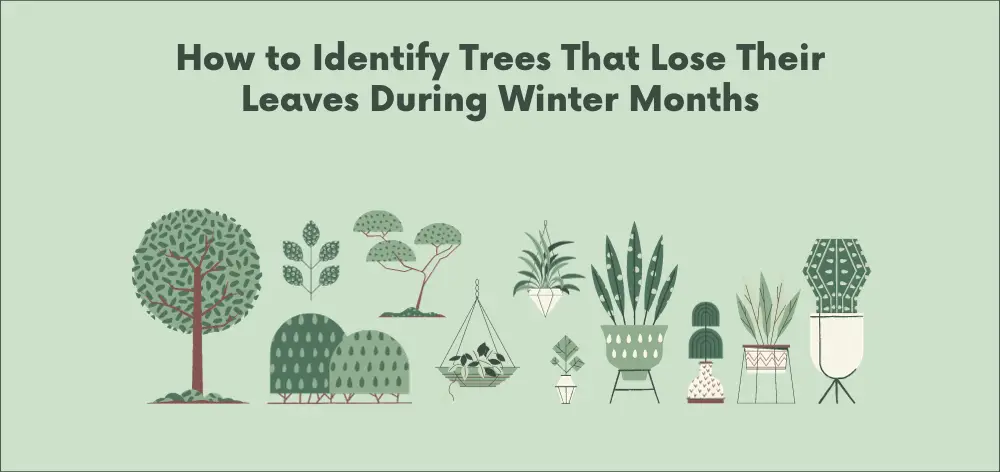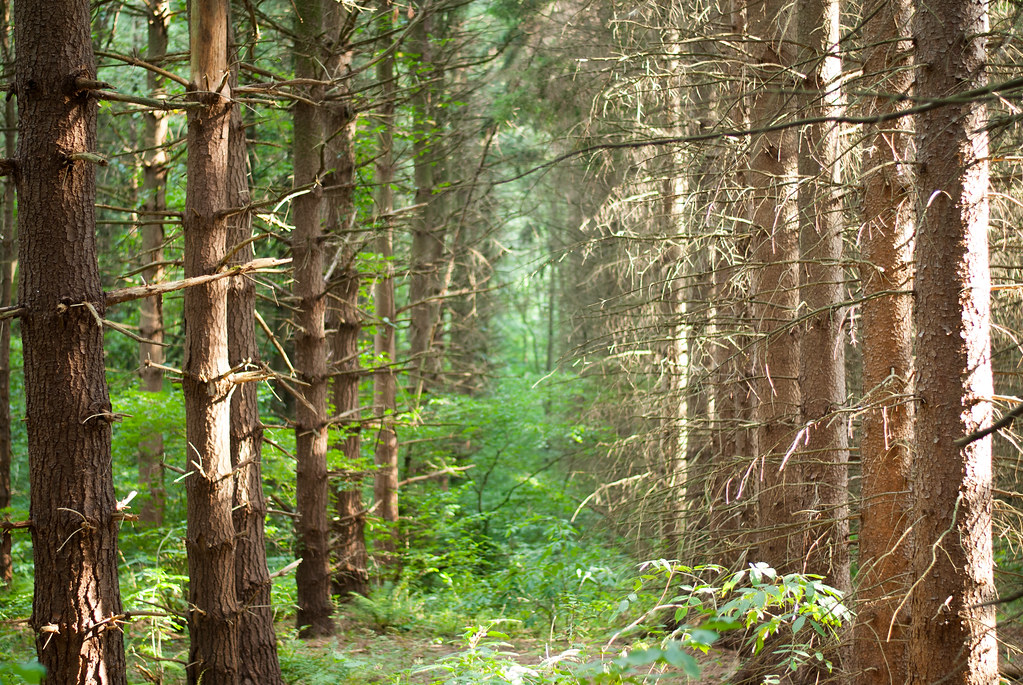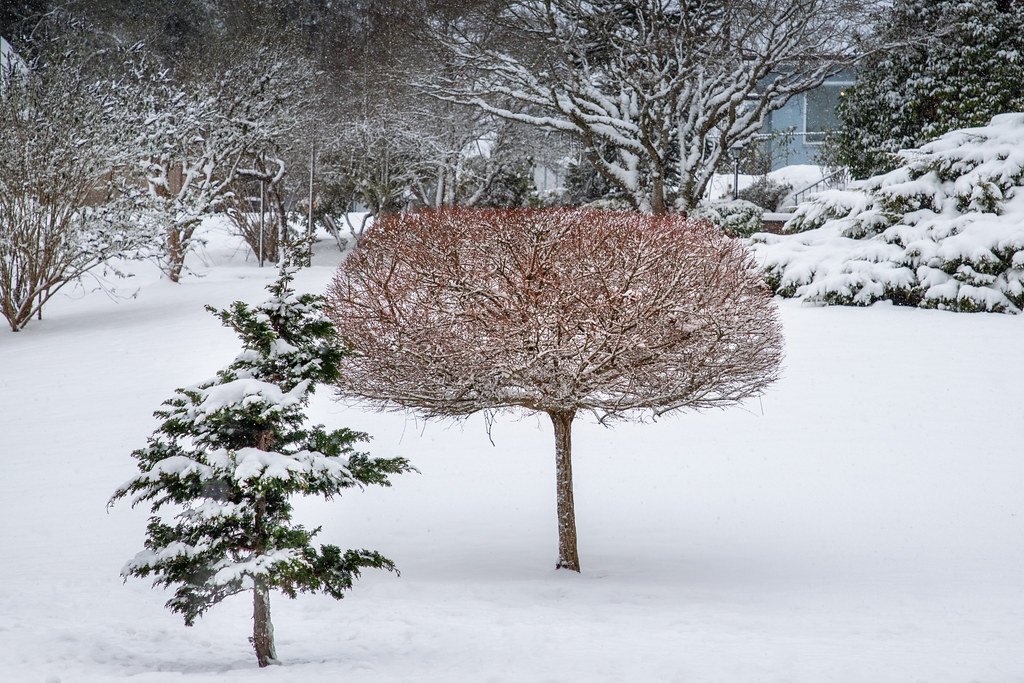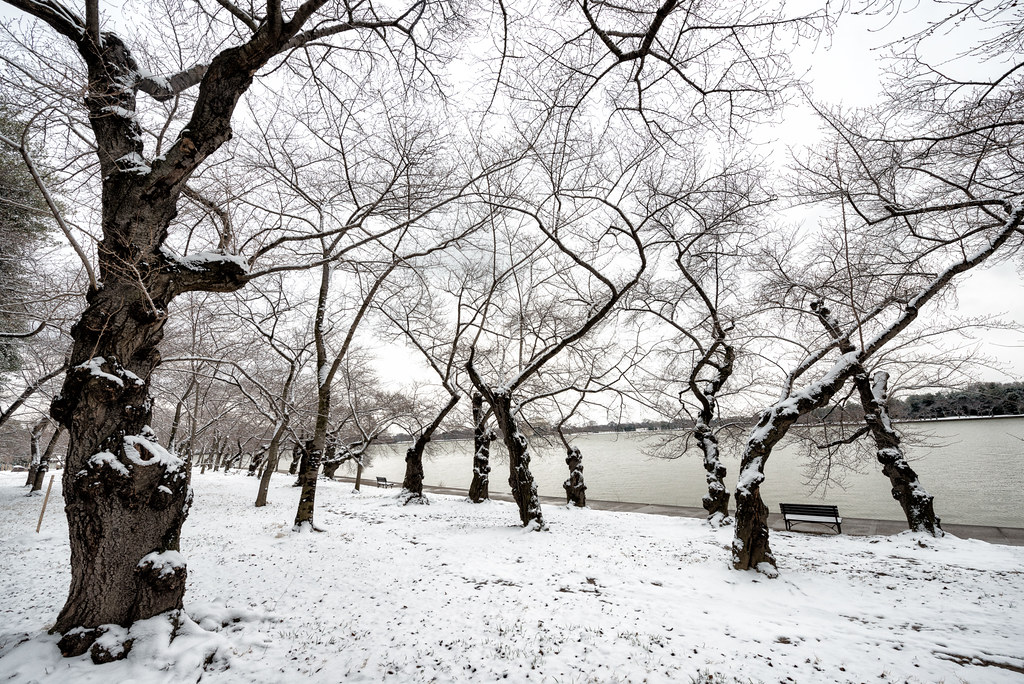Trees that lose their leaves during the winter months are called deciduous trees. Deciduous trees drop their leaves annually as part of their natural life cycle.
Deciduous trees are a familiar sight in many regions of the world, and they are generally found in areas with a moderate climate that allows for the growth and shedding of leaves. In contrast, evergreen trees retain their foliage year-round, and they are better suited to colder regions where snow and ice can damage the delicate leaves.
Tree species vary in their ability to survive winter conditions, and some deciduous trees are better suited to cold weather than others. In this article, we will explore the different types of trees that lose their leaves during the winter months and the factors that contribute to their survival and growth.

Credit: www.skillshare.com
The Process Of Deciduous Trees Losing Leaves
Explanation Of How Deciduous Trees Lose Their Leaves During Winter
Deciduous trees have a yearly cycle of losing and regrowing their leaves. During the fall, deciduous trees undergo a process called abscission, which causes the leaves to dry out and fall off the tree. The process of abscission is a tightly controlled process that involves the tree releasing hormones that trigger the gradual disconnection of the leaf from the branch.
Here’s a brief explanation of the steps involved in the process:
- In the fall, the tree starts the process of abscission by breaking down the chlorophyll in the leaves, which results in vibrant fall colors.
- Next, the tree begins to form a layer of cells at the base of the leaf stem called the abscission layer.
- The abscission layer works to slowly weaken the attachment between the leaf and the branch until the leaf falls off.
- Once the leaf has fallen, the tree seals off the area where the leaf was attached to protect it from disease and insects.
How Deciduous Trees Prepare For Winter
Deciduous trees have evolved in a way that allows them to survive the harsh winter months. Here are some of the ways that deciduous trees prepare for winter:
- As mentioned earlier, in the fall the trees go through the process of abscission, which allows them to shed their leaves and conserve energy during the winter.
- In addition, the trees also undergo physiological changes, such as the thickening of their bark, to protect them from freezing temperatures.
- The trees also slow down their metabolic rate, which helps them conserve energy during the winter months.
- Deciduous trees also store nutrients and water in their roots, which helps them survive dry winter months.
The Physiology Behind The Change Of Leaf Color In Autumn
As mentioned earlier, the vibrant fall colors of deciduous trees are caused by the breakdown of chlorophyll in the leaves. However, there is more to this process than meets the eye. Here are some interesting things to note:
- Chlorophyll is the pigment that gives leaves their green color, and its breakdown is influenced by the amount and intensity of sunlight received.
- As the amount of sunlight decreases during the fall, the trees produce less chlorophyll, which causes the green color to fade.
- At the same time, the trees produce other pigments such as carotenoids, which produce yellow and orange colors, and anthocyanins, which produce red and purple colors.
- The intensity and duration of these colors depend on a combination of factors such as temperature, light, and soil moisture.
The process of deciduous trees losing their leaves during winter is a complex and fascinating process that involves both physiological changes and tightly controlled hormone release. Understanding how deciduous trees prepare for winter can give us a deeper appreciation for the beauty that surrounds us during the fall months.
Winter Wildlife And Deciduous Trees
The Significance Of Deciduous Trees As Winter Homes For Wildlife
Deciduous trees are vital shelters for wildlife during winter. They offer the necessary insulation to protect animals from harsh weather conditions such as cold winds, snow, and frost. The trees’ thick foliage forms a protective barrier that allows wildlife to remain hidden and safe.
Moreover, as deciduous trees shed their leaves during the winter months, they provide excellent hiding spots for animals.
The Animals And Birds That Take Refuge In Deciduous Trees During Winter
Several wild animals and birds seek refuge in deciduous trees during winter because of the trees’ insulating abilities. These include:
- Squirrels: They make leafy nests in the trees’ branch crooks or hollow out trees’ trunks to build their homes.
- Birds: They build nests on the trees’ branches during the winter months for warmth.
- Deer: They hide under and between trees from predators.
- Foxes: They dig dens around the bases of trees.
- Bats: They roost in trees’ crevices and hollows.
How Deciduous Trees Provide Food For Wildlife During Winter
Deciduous trees provide a range of foods to sustain wildlife during winter, such as seeds, berries, and nuts. Some examples of deciduous trees that supply food for wildlife during winter include:
- Oak trees: They produce nuts that are vital food for squirrels and deer.
- Birch trees: They produce small birds’ seeds, which form an essential source of food for birds during winter.
- Maple trees: Their sap is an essential source of food for squirrels, woodpeckers, and other wildlife.
- Aspen trees: They have buds, which provide essential food for deer and elk.
Deciduous trees are an essential ecological resource during winter for many animals and birds. By offering shelter and food, these trees can support many species, allowing them to survive harsh winter conditions.
The Winter Beauty Of Deciduous Trees
Trees That Lose Their Leaves During Winter Months
Witnessing the leaves turn from green to orange, yellow, and brown, it’s easy to fall in love with the autumn season. But as the cold wind begins to blow and the temperature drops, the trees steadily drop their leaves, revealing their bare branches.
The sight of bare trees might seem dull, but deciduous trees have an elevated beauty in winter, which adds to the season’s charm. In this blog post, we’ll explore the unique beauty of deciduous trees during the winter months, focusing on the subheading – the winter beauty of deciduous trees.
The Colorful Bark And Berries Of Deciduous Trees In Winter
Most trees may shed their leaves in the winter, but their bark still holds untold beauty. Here are some of the characteristics that make their bark and berries unique:
- Some deciduous trees have bark in striking, bright shades like red, green, or orange, making each tree a unique sight.
- The colors of the bark and the branches sharply contrast with the white of the snow, making the tree’s bark more prominent.
- The red or yellow berries on the branches of trees like American holly and dogwood, become more visible during winter and add an extra touch of color to the landscape.
The Unique Shapes And Structures Of Deciduous Trees During Dormant Season
In winter, leaves might have fallen, but tree bark isn’t the only aspect of a tree that stands out. The unique shapes and structures of deciduous trees take center stage. Here are some points that highlight the unique shapes and structures of deciduous trees:
- Without leaves, we get to enjoy the tree’s structure, and sometimes, this structure is more beautiful than the tree’s leaves.
- Whether you observe a small or big tree, each one will have its unique shapes to appreciate in winter.
- The bare branches of a deciduous tree create a breathtaking sight that can be enjoyed from afar.
How Different Species Of Deciduous Trees Add To The Winter Landscape
Winter doesn’t mean barren lands and deciduous trees play a significant role in winter landscapes. Here are some points that will discuss how different species of deciduous trees add to the winter landscape:
- A grove of trees of the same species and height will create a cohesive and picturesque landscape.
- The presence of deciduous trees adds life to winter landscapes by providing shelter and food for animals and birds.
- Not all deciduous trees have the same aesthetics, and depending on the species, they have unique features like shape, root structure, bark color, and branching habits.
By appreciating the beauty of trees during the winter season, we gain a newfound appreciation for the natural world. Deciduous trees provide us with unique beauty year-round, whether they have green leaves or bare limbs. With all their various colors, shapes, and structures, deciduous trees continue to inspire and delight us all year round.
Caring For Deciduous Trees In Winter
Trees that lose their leaves during winter months: caring for deciduous trees in winter
Deciduous trees are beautiful, vibrant, and a symbol of the changing seasons. However, the biggest challenge for these trees is to survive the cold winter months where the drop in temperature, snowfall, and gusty winds can be tremendously hard on any tree.
As such, deciduous trees require extra care and attention during winter. In this section, we will go over some essential tips on how to take care of your deciduous trees during winter to ensure their survival.
Tips For Taking Care Of Deciduous Trees During Winter
- Watering: Water your trees deeply if the winter season is dry, especially during prolonged periods of drought. Deciduous trees need a minimum of one inch of water a week, a standard measurement that you can quickly achieve by giving them a long, slow, deep watering session once a week. This allows the tree to store enough water and prepare for the dry months ahead.
- Mulching: Applying a three-inch layer of organic mulch around the base of the tree can help insulate and protect its roots from the harsh winter temperatures. Mulching also helps to retain moisture and suppress weeds so that the tree can make the most of the available water and essential nutrients.
- Wrapping: Protect your trees’ thin barks from the sun and other environmental factors by wrapping them in cloth tree wrap or burlap. Wrapping is especially important for young and delicate trees as it helps prevent sunscald, which can cause long-term damage.
- Clearing: It is essential to clear snow and ice from the tree’s branches and trunk to prevent bending, breakage, and damage to its limbs. You can gently brush off the snow using a broom or gently tap the branches with a soft object until the snow falls off.
Importance Of Pruning And Pest Management During Winter
- Pruning: Winter is an excellent opportunity to prune your deciduous trees. Pruning helps to remove any dead, damaged, or diseased limbs that may be carrying diseases or insects. Pruning also helps to shape the tree to help it become a healthier, safer, and more beautiful tree.
- Pest management: Winter is an ideal time to address pest problems on your trees. An excellent way to do this is by applying dormant oil, which can smother pests and insect eggs. You can also use insecticides to clean any infected branches or trunks to promote healthy growth.
How To Ensure The Survival Of Deciduous Trees Through Winter
- Soil analysis: Before winter sets in, perform a soil analysis to determine if your trees need any additional nutrition. The nutrients, such as nitrogen, potassium, and phosphorus, can help your trees to withstand the harsh winter conditions.
- Winter pruning: Pruning during winter helps the trees to respond more efficiently to the cold weather. This has two major benefits: it reduces the chance of storm damage, and it encourages growth by sending nutrients to the branches.
- Winter protection: Shelters, especially tree guards, can help protect young and delicate trees from harsh winter conditions. The tree guards can prevent damage from animals, herbicides, and pesticides while also providing extra insulation.
Deciduous trees require a lot of care and attention during winter months. By following these tips, you can help ensure that your trees not only survive the winter but come out even more vibrant and beautiful than before.
Frequently Asked Questions On Trees That Lose Their Leaves During Winter Months
Why Do Trees Lose Their Leaves In Winter?
Trees lose their leaves in winter to conserve water and energy. The cold, dry air of winter makes it hard for trees to get enough water from the soil, so they shed their leaves to reduce water loss.
What Are Some Trees That Lose Their Leaves In Winter?
Some of the trees that lose their leaves in winter include maple, oak, birch, elm, and poplar.
Is It Normal For Trees To Lose Their Leaves In Winter?
Yes, it is completely normal for some trees to lose their leaves in winter. It is a natural adaptation to the cold, dry winter conditions.
Do All Trees Lose Their Leaves In Winter?
No, not all trees lose their leaves in winter. Evergreens, such as pine and spruce, keep their leaves throughout the year.
Will The Trees Grow Leaves Again In Spring?
Yes, the trees that lose their leaves in winter will grow new leaves in the spring. It is part of their natural growth cycle.
Conclusion
Overall, the winter season can be quite a sight to behold, especially with all the deciduous trees shedding their leaves. It’s a natural process that each one of us should learn to appreciate and even celebrate. Watching the leaves changing colors and ultimately falling to the ground is a beautiful phenomenon that never fails to amaze us.
With this blog post, we hope that you’ve learned more about the trees that lose their leaves during the winter months, and how they are an integral part of our ecosystem. From the mighty oaks to the more delicate maples, each one of these trees has a unique story to tell.
Therefore, we must do our part to ensure that we protect and care for these trees and the environment they thrive in. Remember, these trees are not just a source of beauty but also play a critical role in purifying the air we all breathe. So, let’s all take a moment to appreciate these trees and everything they do for us.
Related Articles:
Insect Invasion: Threat to Utah’s Fir Forests
 Dr Ahsanur Rahman, PHD
Dr Ahsanur Rahman, PHD
UK Forests Collapse Imminent: Act Now Against Climate!
 Dr Ahsanur Rahman, PHD
Dr Ahsanur Rahman, PHD
Lightning Strikes Threat: Boreal Fires Jeopardize Carbon
 Dr Ahsanur Rahman, PHD
Dr Ahsanur Rahman, PHD









